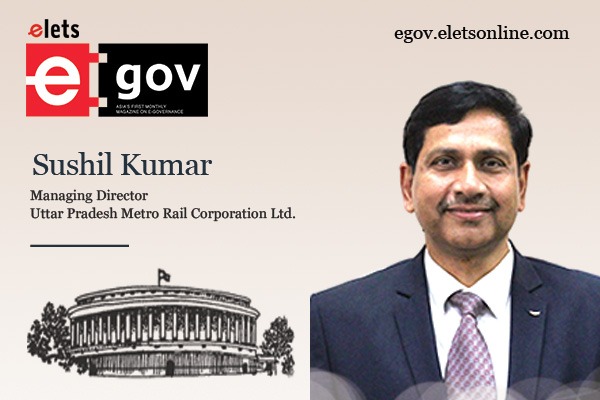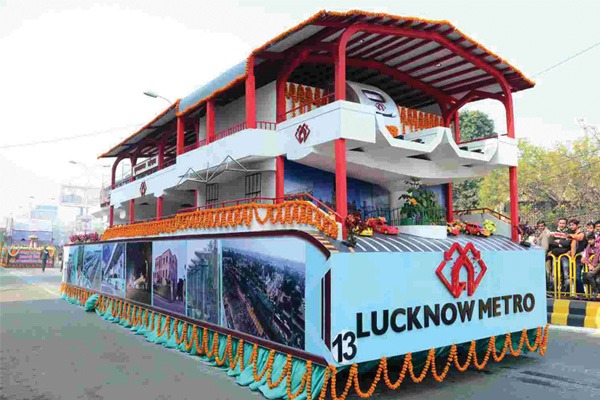
With significant focus on sustainability and eco-friendly initiatives, Lucknow Metro has set a benchmark among other metros across the country; shares Sushil Kumar, Managing Director, Uttar Pradesh Metro Rail Corporation Ltd. in an exclusive interview with Ritika Srivastava of Elets News Network (ENN). Edited excerpts.
As the Managing Director, what challenges have you faced in the expansion and operation of the Lucknow Metro? How did you address these challenges, and what lessons did you learn from them?
Utility identification proved to be a challenge in the expansion and operation of the Lucknow Metro. The whole city had already been used for public facilities like roads and buildings. The older part of the city had a lot of water underground, which made it hard to build things below the ground. The streets in those areas were really crowded, and controlling the traffic became a big problem. Finding substitute ways for the traffic movement had been tough. So, to address these issues, the Uttar Pradesh Metro Rail Corporation (UPMRC) team had to widen some footpaths, remove electrical poles, cables, and also shift some water pipelines and sewer lines. With efficient management, it was ensured that the public did not face any trouble. To ensure smooth traffic movement along with the safety of commuters, most of the heavy structural erection work was carried out at night till the wee hours. The UPMRC team literally worked day and night to ensure maximum comfort for the people of Lucknow.

I would say our biggest achievement was the people’s support. As citizens, it’s not easy to move around with such heavy construction work going on for such a long period of time. However, UPMRC made all possible efforts to minimise people’s diversions and troubles while they passed through the Metro construction sites. We even planned diversions and roadblocks in a phased manner, which ensured that people always had an alternate route nearby with ample manpower on the roads directing people towards the diversions. UPMRC also communicated about the diversions in advance to the media for wide circulation of such information. It is because of these measures that people showered us with full support and immense trust in our work. A huge factor in our success is the people’s support.
The most remarkable achievement was the erection of curved U-girders near the IT intersection for the first time by the Lucknow Metro Project team. The erection of I-girders near the polytechnic intersection was also difficult due to traffic congestion in the area. The major challenges, like the erection of a 225 m long balanced cantilever span at Mawaiya railway crossing with operational Indian railway lines beneath, the erection of a 60 m special steel span at Awadh rotary, a 177 m long balanced cantilever bridge on the Gomti river, and another 60 m special steel span at Nishatganj (constructed in just 5 days), were overcome by strategic planning and careful execution by the dedicated team of engineers.

Another major challenge was to construct an underground tunnel in Hazratganj where we not only had to dig a tunnel beneath the centuries-old buildings but also keep the heritage and cultural beauty intact. Convincing the shop owners was another challenge, who felt their shops would collapse. After due convincing and strategic planning, we delivered what we promised. The beautiful metro stations have added to the majestic charm of the Hazratganj Market, blending in so seamlessly like they were always there.
The construction of the underground metro station around Haidar Canal also attracted lots of challenges from the people residing in slum areas around it. As a suitable solution, over 60 families were relocated to a different place for the period of construction and were also compensated.
Also Read | Uttar Pradesh’s Pursuit of Sustainable Urbanisation
My experience says with the right balance of expertise, strategy, planning, and skills, one can move mountains. You need to have foresight and plan ahead to be able to see the possible challenges and work your way around them.
Lucknow Metro has been praised for its focus on sustainability and eco-friendly initiatives. Could you elaborate on some of the eco- friendly measures the corporation has undertaken, and how do you balance environmental concerns with meeting the transportation needs of the city?
UPMRC ensured that the city’s green cover remained intact, and more green practices were adopted during the construction phase. Approximately 410 trees were transplanted (pulled along with the roots and relocated elsewhere), and the route map’s design was altered at specific locations to preserve over 500 trees. UPMRC also took steps towards waste reduction and the use of renewable resources.
To maintain the cleanliness of the city’s roads, a wheel washing plant was installed at construction sites. Every loading-unloading vehicle leaving the construction site was required to pass through the wheel washing plant. Only after the dirt-packed wheels were washed and cleansed of construction mud, the vehicles were allowed to move onto the city roads from the construction site.
Lucknow Metro has installed a total of 1.032 MW of solar panels across the Transport Nagar Metro Depot and Administrative Building. Additionally, 2 MW of solar panels on the roofs of metro stations are planned and expected to be implemented soon. This initiative will result in saving lakhs on electricity bills, which are charged at commercial rates.

In addition to these solar initiatives, Lucknow Metro has implemented several energy conservation measures. These include the use of regenerative braking in trains, resulting in a saving of 30 to 35 percent of traction energy. Recently, UPMRC also participated in the Energy Exchange Program, becoming the second Metro in India to do so. This has resulted in saving around Rs 10 lakhs worth of energy per month.
The Lucknow Metro in India is a pioneer in using 100% LED lights on its trains and stations. They also use special roof sheets to let in natural light and panels to reduce heat and improve ventilation. This shows their commitment to being eco- friendly.
They’ve also come up with a smart way to save energy on escalators. After 3 minutes of no use, the escalators slow down, and after 6 minutes, they stop completely. This saves a lot of energy, around 2.32 lakh KWh.
At night, they only use specific lights for maintenance on the tracks, which saves about 0.43 lakh KWh of energy every year.
Lucknow Metro has contributed significantly to the city’s public transportation system. How do you see the role of the Metro evolving in the broader urban development and transportation planning of Lucknow?
Metro projects constitute the foundation for facilitating urbanisation, ensuring economic development, and heralding the social transformation of the city. The metro services interconnect the major nodes of the city, reducing commuting time while enhancing connectivity. They also alleviate congestion by decreasing vehicular traffic on the roads and addressing the issue of encroachment. Through the reduction of fuel costs, it has emerged as a cost-effective and sustainable mobility solution.
The enhancement of transportation and infrastructure acts as a catalyst for economic development by attracting multinational firms, creating direct and induced employment opportunities, enhancing tourism prospects, and transforming the city into an industrial, commercial, and business hub. Metro projects also have a ripple effect on ancillary industries such as real estate and manufacturing firms, among others.
The Lucknow Metro has set a benchmark among other metros across the country with the successful implementation of the Mass Rapid Transit system (MRTS). The people of Lucknow are already utilising the Metro in large numbers, especially in congested areas like Charbagh, Singar Nagar, Krishna Nagar, Munshipulia, Hazratganj, etc. A significant advantage of our Metro is its connectivity to the Airport, Railway Station, and Bus Stand, including CCS Airport, Charbagh Railway Station, Alambagh Bus Stand, along with the ‘CCS Airport to Munshipulia’ stretch, facilitating seamless inter-state mobility.
This has significantly improved connectivity and surpasses road transport in terms of decongestion, reduced travel time, and cost. Upon becoming operational, Phase 1-B of the East-West corridor will further enhance connectivity by encompassing densely populated areas in old Lucknow.
Safety is a critical aspect of any transportation system. How does Lucknow Metro Rail Corporation prioritise and ensure the safety of passengers and staff? What measures are in place to address emergency situations and prevent accidents?
- The Lucknow Metro is undoubtedly the safest mode of public transport with a robust surveillance and security system. Various measures and systems that are in place for safe commuting and a secure working environment include:
- Each cab (coach) is equipped with two Passenger Emergency Intercoms (PEIs) for direct communication with the Train Operator in case of emergencies or threats. The CCTV footage from the PEI-equipped coach is automatically transmitted to the Cab, OCC, DCC, and Security Control room.
- There are 24 CCTV cameras per train to monitor activities both inside and outside the train at all times. The feed is displayed in the Driver Cab, Centralised OCC, and Security Control room.
- There are 50 to 60 CCTV cameras per station for continuous monitoring.
- Security checks are conducted regularly.
- There is a presence of female security personnel at all stations.
- There is a presence of female housekeeping staff inside/near women’s washrooms.
- Glass-panelled see-through offices are provided for station controllers, and ticket counters ensure continuous station monitoring.
- The station areas are properly illuminated, with no dark spots.
Metro projects require extensive collaboration with various stakeholders, including the government, private contractors, and the public. How do you manage these relationships and ensure smooth coordination to ensure the project’s success?
Any organisation executing a metro rail project works in close coordination with various government departments. Starting from acquiring the land and obtaining clearances from the Development and Forest Departments, making changes in the design and layout of the project for better connectivity with other transport terminals, securing clearances from the Fire Department and working with organisations focused on assisting individuals with disabilities to gather input for designing stations to facilitate passengers with special needs, among other aspects. Regular meetings and follow-ups are conducted to ensure the smooth execution of the project. Similarly, the media is also kept updated about the progress of every project to ensure that the public is well-informed about ongoing developments, which in turn helps generate trust and cooperation during both the project and operation phases.

The working process with contractors is also completely streamlined, with timely approvals and payment processing being ensured to keep the team motivated and focused. What I am trying to convey is that it’s a two-way street. We adopt a highly proactive approach when it comes to keeping our stakeholders informed and involved at every step, and this approach pays dividends. Government departments tend to place significant trust in our work, and as a result, in situations where roadblocks arise, we receive support from the authorities to keep the project moving forward.
Also Read | Uttar Pradesh’s Urban Facelift: Where Tradition Meets the Future
Similarly, the role of contractors is extremely vital in ensuring the success of our projects. It’s a mutually beneficial professional relationship where we treat our teams like family. For instance, during the second wave of Covid, many civil projects across the country came to a standstill. However, at UPMRC, we not only resumed work after obtaining approvals from the government but also managed to complete the Kanpur Metro Project ahead of the December 2021 deadline. This achievement was made possible due to the Labour colony that UPMRC established to accommodate construction workers near the project site itself. UPMRC provided them with transportation, housing, and medical facilities, in addition to arranging temporary shelters and meals for the labourers. The UPMRC team took great care to maintain hygienic conditions within the premises and on the field to prevent the transmission of Covid.
Be a part of Elets Collaborative Initiatives. Join Us for Upcoming Events and explore business opportunities. Like us on Facebook , connect with us on LinkedIn and follow us on Twitter, Instagram.











